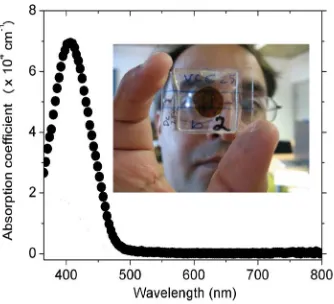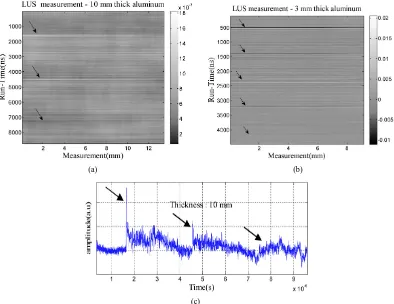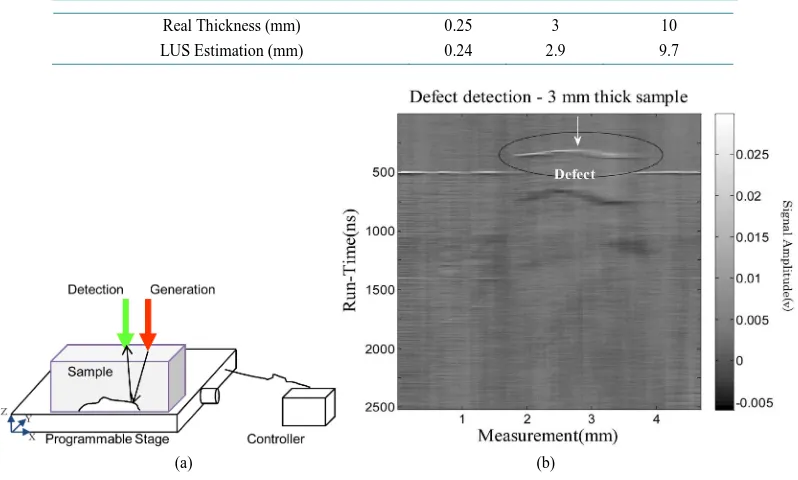How to cite this paper: Zamiri, S., et al. (2015) Employing 532 nm Wavelength in a Laser Ultrasound Interferometer Based on Photorefractive Polymer Composites. Open Access Library Journal, 2: e1247.
http://dx.doi.org/10.4236/oalib.1101247
Employing 532 nm Wavelength in a Laser
Ultrasound Interferometer Based on
Photorefractive Polymer Composites
Saeid Zamiri
1,2, Bernhard Reitinger
2, Mario-Alejandro Rodríguez-Rivera
3,
Gabriel Ramos-Ortíz
3, Peter Burgholzer
1,2, Siegfried Bauer
4, José-Luis Maldonado
3 1Christian Doppler Laboratory for Photo Acoustic Imaging and Laser Ultrasonics, Linz, Austria 2Research Center for Non Destructive Testing GmbH (RECENDT), Linz, Austria3Centro de Investigaciones en Óptica A.C., León, México
4Department of Soft Matter Physics, Johannes Kepler Universität, Linz, Austria
Email: saeid.zamiri@recendt.at
Received 2 January 2015; accepted 19 January 2015; published 23 January 2015
Copyright © 2015 by authors and OALib.
This work is licensed under the Creative Commons Attribution International License (CC BY).
http://creativecommons.org/licenses/by/4.0/
Abstract
Laser ultrasonic (LUS) receivers based on photorefractive (PR) materials are contactless and adap- tive interferometers, which are used widely for materials characterization. Here, we present a simple LUS interferometer at 532 nm operating wavelength based on organic PR polymer compo-sites (PVK/ECZ/C60) doped with the nonlinear chromophore 4-[4-(diethylamino)-2-hydroxyben- zylideneamino] benzonitrile (Dc). A picoseconds laser at 1064 nm wavelength is used to generate ultrasound pulses in aluminum plates and by using this LUS polymer interferometer, detection of these ultrasound waves is remotely performed at the surface of the specimens. The LUS sensor is used to determine the thickness of aluminum plates about 0.25 mm, 3 mm and 10 mm. We also show the potential of this polymer receiver for detection of an artificial defect in a metal sample.
Keywords
Laser Ultrasonic, Photorefractive (PR) Materials, Polymer Composites
Subject Areas: Applied Physics, Composite Material, Material Experiment
1. Introduction
OALibJ | DOI:10.4236/oalib.1101247 2 January 2015 | Volume 2 | e1247 waves in all directions on the surface and inside the sample, which can be remotely detected either at the front or opposite surface of the specimen by means of LUS interferometers. This method has many advantages over conventional techniques based on contact and noncontact piezoelectrics [1]. For laser based detection of ultrasonic waves, several different interferometers such as confocal Fabry-Perot [1], Michelson [1], long path difference [1] and photorefractive (PR) interferometers [4], with different frequency responses and sensitivities are used but most of them are applicable just for samples with high reflective surfaces [1] [4]. For samples with rough surfaces, LUS receivers based on two-wave mixing (TWM) in an adaptive PR material exhibit high sensitivity [4] [5].
For a decade, many photorefractive materials have been used as beam combiners in PR interferometers, how-ever, with different sensitivities, coupling gains and response times [6]-[11]. Among them, PR polymer compo-sites are very promising because of their low-cost, easy preparation and, further, they can be employed for a wide range of wavelengths [11] [12]. The essential diversity between PR crystals and polymers comes from the dielectric constant, which is lower in polymers than in PR crystals and thus, electrical charge generation, trans-portation and trapping is highly field dependent in most of PR organic polymers [11]. The main advantage of these organic composites is their higher PR coupling gain (~10 - 400 cm−1) [6] [11]-[14] in comparison to that of the PR crystals (<40 cm−1) [6], which is an important parameter to be used in LUS interferometers.
In this work, we report on a new LUS homodyne receiver [4] [11], at 532 nm operating wavelength using or-ganic PR composites (To the best of our knowledge, this is for the first time), based on the nonlinear chromo-phore 4-[4-(diethylamino)-2-hydroxybenzylideneamino] benzonitrile (Dc), fullerene C60 as sensitizer, poly (N-
vinylcarbazole) (PVK) as hole transporting polymer, and ECZ as plasticizer [15]. We show that this polymer based LUS interferometer is highly suitable for the remote measurement of the thickness of metal sheets and detection of a subsurface defect position. From these points of view, new operating wavelength at 532 nm for a new PR polymer composite and remotely detection of ultrasonic waves by using this LUS polymer are new techniques in this paper.
2. LUS Experimental Setup
The organic PR polymer samples, Dc:PVK:ECZ:C60 (25:49:25:1 wt%) were synthesized and tested, according
to the reported procedure [15]. Thickness of the PR samples was about 110 µm.Figure 1 shows the absorption spectrum of these PR compounds. As it can be seen, the absorption maximum is at the wavelength of 406 nm and in the range of 500 nm to 800 nm these polymers exhibit relatively low absorption. The absorption coeffi-cient of PR polymer sample at the operation wavelength of 532 nm was measured 22 cm−1. A photograph of the respective PR polymer is shown as the inset photo.
The experimental setup of the LUS receiver is shown in Figure 2. A cw Nd:YAG Klastech laser with a power of 300 mW and 532 nm wavelength was used for detection of the generated ultrasonic pulses on the test samples surface. An optical density filter was used to attenuate the out power of this detection laser to 20 mW.
The p_polarized reference beam (RB) with 10 mW power and spot size of 1 mm by means of mirrors and a lens is directed to the polymer sample. The circular polarized signal beam (SB) is reflected from the rough sur-face of the samples and collected by lenses. After second passing through QWP by means of the lenses, the po-larization gets linear. Finally, the phase modulated signal beam (due to generated ultrasonic vibrations) is fo-cused with power of about 1 mW and a spot size of 1 mm to the PR polymer sample and interfere with the ref-erence beam with an angle of 30˚ between them, the tilted angle of the sample with respect to the normal vector was about 60˚ [15] [16]. The half wave plate and polarizing beam splitter was used to adjust the intensity ratio between reference and signal beam. An external high voltage up to 5 kV was applied to the PR sample, corres-ponding to an applied field of 45 V/µm. Due to the modulated refractive index, a grating is created in the PR sample, and the two beams couple and diffract in the direction of the other beam.
OALibJ | DOI:10.4236/oalib.1101247 3 January 2015 | Volume 2 | e1247
Figure 1. Absorption coefficient of Dc:PVK: ECZ:C60 PR film at 25:49:25:1 [15], photograph of the respective PR polymer composites sample.
Figure 2. Schematic diagram of the experimental laser ultra- sonic receiver based on the PR polymer. HWP: half wave plate for 532 nm; QWP: quarter wave plate; PBS: polarizer beam split- ter; M: mirror; L: lens; SB and RB: signal and reference beam; HV: high voltage power supply; F: filter.
For detection of the interference between the reference and signal beam, the diffracted beam was focused on a fast and broadband Si-photo detector (New Port 1801-FS). An Infrared filter was used to attenuate the effect of picoseconds laser light on the photo-detector. For generation of ultrasonic pulses in the metal samples, a Q- switch Nd:YAG laser (Ekslpa, 1064 nm wavelength) and pulse width of 20 picoseconds at 10 Hz repetition rate and with tunable energy from 1 to 80 mJ was used. The generation pulses were focused on the plate’s backside in a spot size of about 0.2 mm by using a lens and the detection of ultrasonic pulses was performed on the sam-ples front side.
3. Results and Discussion
As a first application of our LUS receiver for the remote thickness measurement of metal sheets, the LUS mea-surements were carried out on aluminum plates with different thicknesses of 0.25 mm, 3 mm and 10 mm. Ps pulses from the generation laser with energy of 1 mJ to 20 mJ (depending on the sample thickness) were focused on the plates and the generated longitudinal waves were detected.
[image:3.595.202.427.285.477.2]OALibJ | DOI:10.4236/oalib.1101247 4 January 2015 | Volume 2 | e1247 (a) (b)
(c)
Figure 3. Detected longitudinal echoes using LUS detector based on PR polymers for (a) 10 mm, (b) 3 mm and (c) a typical LUS measurement for one point on 10 mm thick sample.
be seen, the time of flight of the echoes is periodic, thus by knowing the ultrasound velocity in aluminum (6400 m/s) [1] one can calculate the sample thickness. The real and estimated thicknesses are presented in Table 1, which are in good agreement.
To the best of our knowledge, this is for the first time that the wavelength of 532 nm is employed in a LUS PR polymer for detection ultrasonic waves. M. Klein and coworkers also showed a polymer ultrasonic detector but at 676 nm wavelength [11]. They generated the ultrasonic pulses by using a 5 MHz contact piezoelectric transducer bonded to a quartz mirror as a sample and used their LUS polymer composite setup for detection. In our previous work, we used a He-Ne laser of 632 nm wavelength in a LUS polymer setup for detection of laser generated ultrasonic pulses [16].
From these points of view, new operating wavelength at 532 nm for a new PR polymer composite and re-motely generation and detection of ultrasonic pulses both by lasers are new methods in the present work.
Additionally, to further demonstrate the capability of our LUS receiver, detection of the position of a subsur-face defect was also investigated. An artificial hole of 1 mm diameter and depth of about 2 mm as subsursubsur-face flaw on a 3 mm thick aluminum plate was created. By focusing the pulsed laser (1064 nm) with energy of 10 mJ and spot size 0.2 mm on the opposite side of the plate and scanning 5 mm length of the sample using a pro-grammable stage, the reflected longitudinal echoes from the forward side and thus, the artificial defect were de-tected. In Figure 4(a), a simple scheme of linear surface scanning of the sample for defect detection by genera-tion of ultrasound pulses is displayed. InFigure 4(b), the defect profile and its position are shown. By using the time of flight of the echoes from the imperfection shape (~275 ns to 300 ns), a defect depth from the forwards surface of 1.76 mm to 1.9 mm was determined.
X. Wang and coworkers [17] used a complicated setup to generate and detect the ultrasound pulses in an alu-minum plate with a mirror like surface and their application to sense an artificial defect in the sample. They used a mask to shaped the beam profile of a Q-switched Ti:Al2O3 laser with 800 nm wavelength and 50 ns pulse
[image:4.595.117.511.85.389.2]OALibJ | DOI:10.4236/oalib.1101247 5 January 2015 | Volume 2 | e1247
Table 1. Real thickness and LUS estimated value of the aluminum sheets.
Real Thickness (mm) 0.25 3 10 LUS Estimation (mm) 0.24 2.9 9.7
[image:5.595.115.514.95.335.2](a) (b)
Figure 4. (a) Simple scheme of generation and detection of ultrasonic pulses in a 3 mm thick aluminum sheet for subsurface defect detection; (b) detected longitudinal echoes from an artificial defect on the 3 mm thick aluminum plate.
backside. They changed the laser output profile to a ring shape for focusing and amplifying the ultrasound wave in the sample to detect the flaw in the thermo-elastic regime.
In a previous work [18], we reported on a fully contactless method to focus laser generated bulk and surface ultrasound waves in the thermo-elastic coupling mode by annular shaped illumination. We used a spatial light modulator (SLM) and changed the beam profile of a pulsed picoseconds laser to ring forms and then they were used to focus acoustic waves toward the center in an aluminum sheet. For detection, a fast BSO crystal was used in a two-wave mixing LUS setup and the application of this technique in subsurface defects detection as well as sample thickness measurement were investigated, however, this method was complicated and difficult to use in industrial applications.
From this point of view, the present LUS polymer set up in this paper has some advantages; it is easy to fa-bricate, cheap and contactless LUS setup, by which we were able to detect the subsurface defect for a sample with a high rough surface.
4. Conclusion
We presented a simple LUS receiver based on Dc:PVK:ECZ:C60 PR polymer composites and employing 532
nm detection wavelength. This receiver was utilized successfully to detect ultrasonic displacements on alumi-num plates with thicknesses of 10 mm, 3 mm and 0.25 mm. By measuring the time of flight of the detected lon-gitudinal waves in the samples, thicknesses were estimated. The LUS polymer detector was applied to detect a hole as a subsurface defect. By scanning the sample surface, the defect position and its profile were measured. In this work, the LUS measurements showed the large potential of organic PR polymer based ultrasonic receivers for non-contact and nondestructive testing investigations on materials.
Acknowledgements
OALibJ | DOI:10.4236/oalib.1101247 6 January 2015 | Volume 2 | e1247
References
[1] Scruby, C.B. and Drain, L.E. (1990) Laser Ultrasonics: Techniques and Applications. Adam Hilger, Bristol.
[2] Banet, M.J., et al. (1998) High Precision Film Thickness Determination Using a Laser-Based Ultrasonic Technique.
Applied Physics Letters, 73, 169-171. http://dx.doi.org/10.1063/1.121780
[3] Davies, S.J., et al. (1993) Laser-Generated Ultrasound: Its Properties, Mechanisms, and Multifarious Applications.
Journal of Physics D: Applied Physics, 26, 329. http://dx.doi.org/10.1088/0022-3727/26/3/001
[4] Honda, T., et al. (1995) Optical Measurement of Ultrasonic Nanometer Motion of Rough Surface by Two Wave Mix-ing in Bi12SiO20. Japanese Journal of Applied Physics, 34, 3737. http://dx.doi.org/10.1143/JJAP.34.3737
[5] Tuovinen, H., et al. (1998) Directionally Sensitive Photorefractive Interferometric Line Receiver for Ultrasound Detec-tion on Rough Surfaces. Applied Physics Letters, 73, 2236. http://dx.doi.org/10.1063/1.121687
[6] Günter, P. and Huignard, J.P. (2007) Photorefractive Material and Their Applications. Springer Series in Optical Sci- ences, 115, 5-6.
[7] Ivleva, L.I., et al. (2003) Two- and Four-Wave Mixing in SBN:Ni Crystals. Laser Physics, 13, 251.
[8] Pouet, B.F., et al. (1996) Heterodyne Interferometer with Two-Wave Mixing in Photorefractive Crystals for Ultra-sound Detection on Rough Surfaces. Applied Physics Letters, 69, 3782.
[9] Garcia, P.M., et al. (1995) Self-Stabilized Holographic Recording in LiNbOs:Fe Crystals. Optics Communications, 117, 235-240. http://dx.doi.org/10.1016/0030-4018(95)00157-4
[10] Blouin, A., et al. (1994) Detection of Ultrasonic Motion of a Scattering Surface by Two-Wave Mixing in a Photore-fractive GaAs Crystal. Applied Physics Letters, 65, 932. http://dx.doi.org/10.1063/1.112153
[11] Klein, M.B., et al. (1999) Homodyne Detection of Ultrasonic Surface Displacements Using Two-Wave Mixing in Photo- refractive Polymers. Optics Communications, 162, 79-84. http://dx.doi.org/10.1016/S0030-4018(99)00023-1
[12] Köber, S., et al. (2011) Organic Photorefractive Materials and Applications. Advanced Materials, 23, 4725-4763.
http://dx.doi.org/10.1002/adma.201100436
[13] Ostroverkhova, O., et al. (2004) Organic Photorefractive: Mechanisms, Materials, and Applications. Chemical Reviews,
104, 3267-3314. http://dx.doi.org/10.1021/cr960055c
[14] Maldonado, J.L., et al. (2009) High Diffraction Efficiency at Low Electric Field in Photorefractive Polymers Doped with Arylimine Chromophores. Journal of Physics D: Applied Physics, 42, Article ID: 075102.
http://dx.doi.org/10.1088/0022-3727/42/7/075102
[15] Herrera-Ambriz, V., et al. (2011) Highly Efficient Photorefractive Organic Polymers Based on Benzonitrile Shiff Bases Nonlinear Chromophores. Journal of Physical Chemistry C, 115, 23955-23963. http://dx.doi.org/10.1021/jp206204p
[16] Zamiri, S., et al. (2014) Laser Ultrasonic Receivers Based on Organic Photorefractive Polymer Composites. Applied Physics B: Lasers and Optics, 114, 509-515. http://dx.doi.org/10.1007/s00340-013-5554-7
[17] Wang, X., et al. (1996) Focused Bulk Ultrasonic Waves Generated by Ring-Shaped Laser Illumination and Application to Flaw Detection. Journal of Applied Physics, 80, 4274. http://dx.doi.org/10.1063/1.363387


